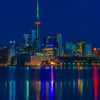A point that's often overlooked when discussing how to shoot a full moon
Oct 28, 2018 07:53:42 #
My moon, shot from the porch of my house in mid-town Toronto. D810, Nikkor AFS 300mm f/4, TC17II, tripod.
Oct 28, 2018 07:54:05 #
dpullum wrote:
Thank you for your - as always - entertaining and insightful insights, Don Considering Bob has given us an excellent download... (show quote)

Oct 28, 2018 08:17:43 #
User ID wrote:
Your head hurts ? Not your fault. It's not a good ... (show quote)
Both explanations are excellent. There are Science geeks and Tech geeks ( and there are some in the audience who are both :) ) The visual backup in your recommended article was appreciated.
Oct 28, 2018 08:21:28 #
selmslie wrote:
As I said, "... some other articles suggest t... (show quote)
My point is, so what? Have you ever seen moire in an image that did not include clothing, window screens, etc.? YES.
Oct 28, 2018 08:38:09 #
Oct 28, 2018 08:38:13 #
Fotomacher wrote:
Thanks for posting! This topic is about discussion of settings, specifically why you chose them and why they work for you. So please elaborate on what I see in exif as f/11, 1/60 sec, and ISO 31???My moon, shot from the porch of my house in mid-town Toronto. D810, Nikkor AFS 300mm f/4, TC17II, tripod.
Appreciated!
Oct 28, 2018 08:41:14 #
abc1234 wrote:
Never use this rule. It is totally obsolete. And how would you use it at night? Spot meter the moon. All you care about is how bright the moon itself is. You will be surprised how bright it is.
With respect, how can a rule, Sunny 16, that has worked for decades be obsolete? If it still works, and it works just fine for people who use it, then it is still a viable concept for taking photos. Nothing has changed in photography that would make the rule obsolete. Explain please.
Dennis
Oct 28, 2018 08:53:24 #
Oct 28, 2018 09:13:32 #
Architect1776 wrote:
My point is, so what? Have you ever seen moire in an image that did not include clothing, window screens, etc.? YES.
I have never seen an image with moire that did not include clothing, screens or other man-made materials.
Feathers don't count since in that case moire does not detract from their beauty.
Perhaps you might like to post some evidence of this claim on a separate thread. This may not be the place to pursue this question.
Oct 28, 2018 09:23:57 #
BooIsMyCat
Loc: Somewhere
2. Shutter speed is relevant because the moon is moving and you or your camera may be also.
3. ISO is relevant because many cameras produce better quality images with lower ISO.
It is amazing how many people don't understand that Looney 11 (or even Sunny 16) is a guideline - not a hard and fast rule. If you set your camera to F/11, ISO 100 and SS 1/125th and your photo is too bright (overexposed) for your liking, it doesn't mean you have to accept that... increase your SS or decrease your Aperture a stop or two and take another shot.
I see so many people posting moon images with an ISO of 1600 or even higher! WHY is the only question that comes to mind but, you can't ask that without hurting their feelings. I suspect many of these people use Auto ISO.
The surface of the FULL moon is very bright - it's like taking a photo at noontime on a bright sunny day. You normally would not set your ISO to 1600/3200 under those conditions unless you were looking for a very high shutter speed so why do it at nighttime on a FULL moon. Many people think that they set their ISO to 1600/3200 for night skies so that's the setting they should use for FULL moon photos too.
I usually use between f/7.1 - f/11, ISO 100 ss 1/125th for my FULL moon photos and I will adjust my ss to get the exposure I think gives me the best exposure.
I never use anything but an ISO of 100. Could I? Sure! but, if I'm handholding the camera, a slower shutter speed is not going to be my friend.
One way to think about your settings is to use the aperture that you consider it's "sweet spot" and adjust your ss accordingly.... keeping your ISO as low as possible (which means 100 for Canon, 200 for Nikon).
I also use Manual focus and LiveView so that I can zoom in to set my focus.
3. ISO is relevant because many cameras produce better quality images with lower ISO.
It is amazing how many people don't understand that Looney 11 (or even Sunny 16) is a guideline - not a hard and fast rule. If you set your camera to F/11, ISO 100 and SS 1/125th and your photo is too bright (overexposed) for your liking, it doesn't mean you have to accept that... increase your SS or decrease your Aperture a stop or two and take another shot.
I see so many people posting moon images with an ISO of 1600 or even higher! WHY is the only question that comes to mind but, you can't ask that without hurting their feelings. I suspect many of these people use Auto ISO.
The surface of the FULL moon is very bright - it's like taking a photo at noontime on a bright sunny day. You normally would not set your ISO to 1600/3200 under those conditions unless you were looking for a very high shutter speed so why do it at nighttime on a FULL moon. Many people think that they set their ISO to 1600/3200 for night skies so that's the setting they should use for FULL moon photos too.
I usually use between f/7.1 - f/11, ISO 100 ss 1/125th for my FULL moon photos and I will adjust my ss to get the exposure I think gives me the best exposure.
I never use anything but an ISO of 100. Could I? Sure! but, if I'm handholding the camera, a slower shutter speed is not going to be my friend.
One way to think about your settings is to use the aperture that you consider it's "sweet spot" and adjust your ss accordingly.... keeping your ISO as low as possible (which means 100 for Canon, 200 for Nikon).
I also use Manual focus and LiveView so that I can zoom in to set my focus.
Oct 28, 2018 09:30:10 #
BooIsMyCat wrote:
There are two possible answers that come immediately to my mind that answer why:I see so many people posting moon images with an ISO of 1600 or even higher! WHY is the only question that comes to mind...
1. the user has not yet learned the basics of exposure (and specific to shooting the moon, your own observation "but it's nighttime!"
 )
)2. it was an oops moment
This topic was intended to help address answer #1.
Hurt feelings? Where and how you ask why is obviously important. But anonymity without repercussion, except in the most egregious instances, is where we are, so it's easy to be rude and mean. And easier now that Admin has removed the topic "blocking" function of the Ignore button

For #2, I'm pretty sure most of us can relate.
Many thanks for your interest and conversation!
Oct 28, 2018 09:33:38 #
BooIsMyCat wrote:
... keeping your ISO as low as possible (which means 100 for Canon, 200 for Nikon). ...
I have not seen ISO 200 as a minimum for Nikon since I got rid of my D70. Base ISO has been 100 for a long time.
On the other hand, ISO 320 is the base ISO for the Leica Monochrom sensors, partly because they have no Bayer array and no AA filter at 18 MP or 24 MP.
Oct 28, 2018 09:46:05 #
BooIsMyCat
Loc: Somewhere
selmslie wrote:
I have not seen ISO 200 as a minimum for Nikon since I got rid of my D70. Base ISO has been 100 for a long time.
On the other hand, ISO 320 is the base ISO for the Leica Monochrom sensors, partly because they have no Bayer array and no AA filter at 18 MP or 24 MP.
On the other hand, ISO 320 is the base ISO for the Leica Monochrom sensors, partly because they have no Bayer array and no AA filter at 18 MP or 24 MP.
Thanks for pointing that out.
The point being - Use the BASE ISO for WHATEVER camera you are using.
Oct 28, 2018 09:51:33 #
[quote=
1. Depth of field is not relevant if you are shooting just the moon itself,
2. Shutter speed is relevant because the moon is moving and you or your camera may be also.
3. ISO is relevant because many cameras produce better quality images with lower ISO.
Great points! I always follow these three steps.
For me I also like to use a tripod, mirror up (Live View) and manual focus.
1. Depth of field is not relevant if you are shooting just the moon itself,
2. Shutter speed is relevant because the moon is moving and you or your camera may be also.
3. ISO is relevant because many cameras produce better quality images with lower ISO.
Great points! I always follow these three steps.
For me I also like to use a tripod, mirror up (Live View) and manual focus.
Oct 28, 2018 10:04:58 #
BooIsMyCat wrote:
Thanks for pointing that out.
The point being - Use the BASE ISO for WHATEVER camera you are using.
The point being - Use the BASE ISO for WHATEVER camera you are using.
I used to recommend base ISO at all costs until I carefully reviewed a lot of the images I had been shooting.
I can only begin to see noise in images captured on a D610, Df or A7 II starting at ISO 800 (I have to look very closely to find it). It become more apparent at 1600 and above.
What I have found is that, with most modern cameras, there is a practical advantage to using a higher ISO - higher hand-held shutter speeds.
So, at least with my own choice of subject matter, I feel safe using anything from 100 through 400. ISO 400 lets me hand-hold at reasonable shutter speeds in daylight when following Sunny 16 - 1/800 @ f/11. The main thing to remember is that Sunny 16 does not mean setting the aperture to f/16.
For egrets with a long telephoto lens where noise is not an issue, I prefer ISO 800 and 1/2000 @ f/11. I would use this setting for the moon as well and brighten the rendition in PP if necessary.
If you want to reply, then register here. Registration is free and your account is created instantly, so you can post right away.









